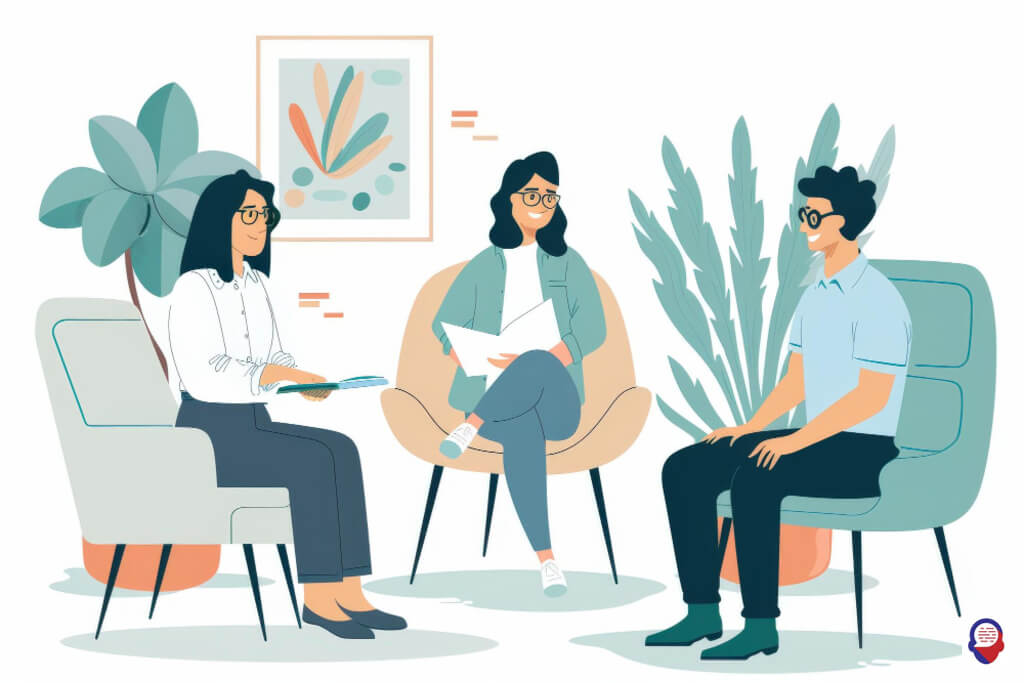Healing Your Relationship with Food Through Schema Therapy
An eating disorder is rarely just about food, weight, or body image. Those are the symptoms, the visible part of a much deeper struggle. For many, it’s a battleground where feelings of worthlessness, fear, and emptiness are fought every single day. You might feel trapped in a cycle you can’t break, a secret war waged against your own body. What if there was a way to understand the root cause of this war, to go beyond managing behaviours and start healing the original wounds?
Schema Therapy offers this deeper path. It’s a powerful approach that looks beneath the surface of the eating disorder to the underlying emotional patterns, or “schemas,” that have been driving the pain for years, often since childhood. It’s a journey to understand not just what you are doing, but why you are doing it. This is about rewriting your story from the inside out, building a foundation of self-worth and compassion so strong that the eating disorder no longer has a place to hide.

What Is An Eating Disorder, Really?
An eating disorder is a serious and complex mental health condition characterized by persistent, unhealthy eating behaviours that negatively impact your health, your emotions, and your ability to function in important areas of life. It’s not a choice or a phase, but a coping mechanism gone awry, an attempt to manage overwhelming emotional pain.
These conditions, including anorexia nervosa, bulimia nervosa, and binge eating disorder, are about so much more than a desire to be thin. They are often rooted in deep-seated feelings of inadequacy, a desperate need for control, or an inability to cope with difficult emotions. The focus on food becomes a way to distract from or numb the real source of the distress. It provides a false sense of order in a world that feels chaotic and unsafe.
Ultimately, an eating disorder is a silent scream for help. It’s a language of pain expressed through the body when words are not enough. Healing requires looking past the food and the weight to address the emotional turmoil that fuels the destructive cycle.

What Is Schema Therapy?
Schema Therapy is an integrative approach to therapy that helps people identify and change lifelong, self-defeating patterns of thinking, feeling, and behaving, also known as schemas. It combines elements of cognitive behavioural therapy (CBT), psychodynamic therapy, and emotion-focused therapies to address the deep-rooted origins of psychological distress.
Developed by Dr. Jeffrey Young, this therapy operates on the premise that many of our current problems stem from unmet core emotional needs during childhood and adolescence. When these fundamental needs are not met, we develop unhealthy beliefs about ourselves, others, and the world. Schema Therapy aims to heal these schemas, allowing for healthier ways of relating to oneself and navigating life’s challenges.

Where Do These “Schemas” Come From?
Schemas originate from a combination of our innate temperament and our early life experiences, particularly when our core emotional needs were not adequately met by our caregivers. These formative years are when we build our fundamental understanding of how the world works and what our place is in it.
Think of schemas as emotional blueprints. If a child consistently experiences criticism instead of acceptance, they might develop a “Defectiveness” schema, believing they are inherently flawed. If their environment is unstable or unpredictable, an “Abandonment” schema might form, creating a lifelong fear of being left alone. These patterns are not about blaming parents, who often did the best they could, but about understanding the emotional legacy of our upbringing.

What Are The Core Emotional Needs?
The core emotional needs are the universal psychological requirements for healthy development, much like a plant needs sunlight and water to grow. When these needs are met, we develop into resilient, well-adjusted adults.
First is the need for secure attachments, which includes safety, stability, nurturing, and acceptance from others. We also have a need for autonomy, competence, and a sense of identity, to feel capable and independent in the world. Another crucial need is for realistic limits and self-control, which helps us learn to manage frustration and work towards goals. The freedom to express valid needs and emotions without fear of punishment or guilt is also essential. Finally, we all have a core need for spontaneity and play, the ability to experience joy, fun, and relaxation.

What Are Maladaptive Schemas?
Maladaptive schemas are the deeply entrenched, negative beliefs and feelings about oneself and the world that develop when core emotional needs go unmet. These schemas act as filters, colouring our perception of reality and causing us to interpret events in a way that confirms our negative beliefs, even when evidence points to the contrary.
For example, the “Emotional Deprivation” schema is the belief that your need for love and emotional support will never be met by others, leading to feelings of emptiness and loneliness. The “Unrelenting Standards” schema involves the relentless pressure to meet impossibly high internal standards of performance and behaviour to avoid criticism, often at the expense of happiness and health. These schemas feel like absolute truths and trigger intense emotional pain when activated.

How Does Schema Therapy Connect to Eating Disorders?
Schema Therapy connects to eating disorders by identifying the eating disorder itself as a maladaptive coping mechanism used to manage the intense pain caused by underlying schemas. The restrictive eating, binging, or purging are not the problem, they are the attempted solution to a much deeper emotional wound.
When a painful schema like “Defectiveness/Shame” is triggered, the feeling can be unbearable. The eating disorder offers a distraction and a false promise. It might whisper, “If you can just control your weight, you won’t feel so flawed,” or “Binging will numb this emptiness.” The eating disorder behaviours, therefore, serve a purpose, they are a way to either numb the schema’s pain (surrender), avoid situations that trigger it (avoidance), or fight against it (overcompensation). Healing means finding healthier ways to meet the needs the eating disorder is trying to fulfill.

Which Schemas Are Common in Eating Disorders?
Several specific schemas are frequently found at the core of an eating disorder, acting as the fuel for the fire. Understanding these patterns can be the first step toward dismantling their power.
One of the most pervasive is the “Defectiveness/Shame” schema. This is the profound belief that you are inherently flawed, unlovable, and inferior. The eating disorder becomes a desperate attempt to fix this perceived internal flaw with an external solution, chasing a “perfect” body in the hope that it will finally make you feel worthy of love and acceptance.
Another common pattern is the “Unrelenting Standards/Hypercriticalness” schema. This involves an internal pressure to be perfect in every way. This isn’t just healthy ambition, it’s a punishing drive that says you are never good enough. This schema translates directly into extreme dieting rules, punishing exercise routines, and a constant, vicious self-critique about any perceived failure, creating a cycle of striving and self-loathing.
The “Emotional Deprivation” schema also plays a significant role. This is the pervasive feeling that your needs for affection, empathy, and guidance will never be met. This creates a deep sense of emptiness and loneliness. For some, binging becomes a way to physically fill that emotional void, while for others, restriction and the feeling of hunger can create a sense of control or even a feeling of being “full” on self-discipline.
We also often see the “Subjugation” schema. This involves sacrificing your own needs and desires to please others or avoid conflict and abandonment. Years of suppressing your own voice can lead to a lost sense of self. The eating disorder can become a paradoxical, non-verbal way to assert control, express distress, or have something that is truly “yours” when everything else feels like it belongs to others.
Finally, the “Abandonment/Instability” schema is a powerful driver. This is the persistent fear that you will lose anyone you form an attachment to, that you will inevitably be left alone. This terror can lead to a belief that if you can control your body and make it more “desirable,” you can prevent people from leaving you. The control over food and weight provides a fragile sense of security in a world that feels terrifyingly unstable.

What Are Schema Modes?
Schema modes are the intense, moment-to-moment emotional states and coping responses that we all experience. They are the “parts” of ourselves that take over when our core schemas are triggered. Think of it like this, schemas are the underlying beliefs, while modes are how those beliefs show up in our personality in real-time.
When you’re in a specific mode, you feel and act in a certain way. You might suddenly shift from feeling capable and calm to feeling like a small, terrified child, or a raging, critical bully. Schema Therapy helps you identify these different modes, understand what triggers them, and learn how to manage them so your healthy adult self can stay in charge. This is crucial for eating disorder recovery, as the disorder is often driven by a powerful set of destructive modes.

What Are the Child Modes?
Child modes are the parts of us that hold the emotions and experiences of our childhood. They are not childish, they are the living memory of the child we once were, and they carry our deepest vulnerabilities and unmet needs.
The “Vulnerable Child” mode is where we feel the raw pain of our schemas. When this mode is active, we feel lonely, sad, defective, anxious, or misunderstood, just as we did as children. It is the Vulnerable Child’s pain that the eating disorder behaviours are trying to soothe or silence. An urge to binge or restrict is often a direct response to the overwhelming distress of this mode.
Then there is the “Angry Child” mode. This part feels intense anger and rage because its core emotional needs were not met. This anger can be directed outwards, but in individuals with eating disorders, it is often turned inward through self-punishing behaviours like severe restriction or purging.
The “Impulsive/Undisciplined Child” mode acts on immediate desires and impulses to get its needs met, without regard for consequences. This mode can drive binge eating, where the immediate gratification of the food overrides any long-term health goals. It’s a desperate attempt to feel good, right now.

What Are the Maladaptive Coping Modes?
Maladaptive coping modes are the survival strategies we developed in childhood to deal with the pain of unmet needs and difficult situations. While they may have been necessary to get through a tough childhood, they become the problem in adulthood, preventing us from getting our needs met in healthy ways.
The “Detached Protector” is a prominent coping mode in eating disorders. Its job is to numb all emotion to avoid the pain of the Vulnerable Child. It creates a sense of emptiness, disconnection, and emotional flatness. This mode is active during the dissociative, trance-like state of a binge, the emotional deadening of starvation, or the compulsive focus on exercise. It’s a way to check out from life to avoid feeling.
Another key mode is the “Overcompensator.” This mode tries to fight against the schema by doing the exact opposite. If the schema is “Defectiveness,” the Overcompensator mode will strive for perfection and superiority. It is the relentless, driven part that pushes for extreme achievement, whether through academic success, career ambition, or, most relevantly, the pursuit of a “perfect” body. This mode fuels the hypercriticalness and unrelenting standards that are so common in anorexia and orthorexia.

What Is the Punitive/Critical Parent Mode?
The Punitive or Critical Parent mode is the internalized voice of caregivers or other influential figures who were critical, demanding, or punishing. This mode is the inner bully, the source of relentless and vicious self-criticism.
This is the voice of the eating disorder. It’s the mode that says, “You’re disgusting,” “You’re a failure for eating that,” “You don’t deserve to eat,” or “You have to work harder to burn that off.” It attacks the Vulnerable Child for having needs and feelings, and it punishes any perceived mistake with intense shame and self-hatred. In Schema Therapy, a major goal is to fight back against this toxic inner critic and ultimately remove it from power, replacing it with a voice of compassion and self-acceptance.

How Does Schema Therapy Actually Work in a Session?
Schema Therapy sessions are active, structured, and deeply collaborative, going far beyond just talking about problems. The therapist works with you to identify your core patterns and then uses a range of powerful emotional, cognitive, and behavioural techniques to heal the underlying wounds and build healthier ways of coping.
The process is designed to be experiential, meaning you don’t just intellectually understand your schemas, you feel the change on an emotional level. It’s about creating new, positive emotional experiences in the therapy room that can challenge and ultimately rewrite the old, painful blueprints from your past. The relationship with the therapist is central to this healing process.

What Is the Assessment Phase?
The assessment phase is the foundational first step where you and your therapist work together to create a map of your inner world. This is a process of discovery, not judgment, aimed at understanding the specific schemas and modes that are driving the eating disorder.
This phase typically involves in-depth conversations about your life history, your relationship with your parents, and significant past experiences. You will also likely complete specialized questionnaires, such as the Young Schema Questionnaire (YSQ), which helps to pinpoint which of the 18 maladaptive schemas are most prominent for you. The goal is to develop a shared understanding, a “case formulation,” that clearly links your childhood experiences to your current struggles, making sense of why you feel and act the way you do.

What Therapeutic Techniques Are Used?
Schema Therapy utilizes a variety of powerful techniques designed to heal on an emotional level. The therapist chooses specific interventions based on your unique schema and mode map.
One of the most powerful techniques is “Imagery Rescripting.” In this exercise, you are guided to recall a distressing childhood memory linked to a core schema. You visualize the scene, but this time, things happen differently. Your adult self, and sometimes the therapist, enters the image to stand up for the child, comfort them, and provide what they needed at that moment. This doesn’t change the past, but it profoundly changes the emotional meaning of the memory, healing the wound at its source.
Another core technique is “Chair Work.” This involves using different chairs to represent different parts of yourself, such as your Vulnerable Child mode, your Critical Parent mode, and your Healthy Adult mode. By moving between chairs and speaking from the perspective of each mode, you can create a dialogue between them. This allows you to challenge the Critical Parent’s voice directly and give your Vulnerable Child the compassion it deserves, fostering internal integration and self-compassion.
The therapeutic relationship itself is a key technique known as “Limited Reparenting.” Within the safe and professional boundaries of therapy, the therapist provides the warmth, validation, and stability that may have been missing in your childhood. This consistent, caring relationship helps to directly challenge schemas like “Emotional Deprivation” or “Abandonment” and provides a new, healthy template for relationships that you can internalize over time.

What Is the Goal of Schema Therapy?
The ultimate goal of Schema Therapy is to help you get your core emotional needs met in healthy, adaptive ways, thereby reducing the power of your schemas and maladaptive modes. It’s about breaking free from the lifelong patterns that have kept you stuck.
The central aim is to build and strengthen your “Healthy Adult” mode. This is the part of you that is competent, compassionate, and resilient. The Healthy Adult can nurture and protect the Vulnerable Child, set limits on the Angry and Impulsive Child modes, and actively fight back against the Critical Parent and maladaptive coping modes.
As your Healthy Adult mode gets stronger, you are no longer at the mercy of your triggers. You can choose how to respond to life’s challenges rather than reacting automatically with self-destructive eating disorder behaviours. The goal isn’t just to stop the behaviours, it’s to build a life that is rich, connected, and meaningful, a life where you feel fundamentally worthy and secure, free from the tyranny of the eating disorder.
Frequently Asked Questions

How long does Schema Therapy take for an eating disorder?
Schema Therapy is considered a long-term therapy, as it aims to change deeply ingrained life patterns. The duration can vary significantly based on the complexity of the issues, but treatment for a long-standing eating disorder often lasts for a year or more, with sessions typically held weekly. It is not a quick fix but a deep, transformative process.

Is Schema Therapy suitable for all types of eating disorders?
Yes, the principles of Schema Therapy can be effectively applied to the full spectrum of eating disorders, including anorexia nervosa, bulimia nervosa, binge eating disorder (BED), and other specified feeding or eating disorders (OSFED). Because it focuses on the underlying emotional drivers rather than just the surface-level symptoms, it is adaptable to the unique manifestation of each individual’s struggle.

Can I do Schema Therapy alongside other treatments?
Absolutely, and it is often recommended. For eating disorders, a multidisciplinary approach is the gold standard of care. Schema Therapy works very well alongside nutritional counselling from a registered dietitian and medical monitoring from a doctor to ensure physical health and safety are managed while the deeper psychological work is being done.

Is Schema Therapy just about blaming my parents?
No, Schema Therapy is not about assigning blame. While it does explore how early experiences and relationships shaped your internal world, the focus is on understanding and empathy, not blame. The goal is to comprehend the origins of your pain so you can heal the wounded parts of yourself in the present, regardless of the intentions or circumstances of your caregivers.
Your story matters. The patterns driving your eating disorder are not your fault, but healing is your choice. At Counselling-uk, we provide a safe, confidential, and professional place to understand these deep-rooted patterns and build a new path forward. You don’t have to navigate this alone. Reach out today to connect with a therapist who can support you through every challenge on your journey to recovery.




Overall, schema therapy has been found to be effective in treating many different types of eating disorders including anorexia nervosa, bulimia nervosa, binge eating disorder, etc., as well as providing long-term benefits such as improved functioning at home/school/workplace; increased self-esteem; better communication skills; improved ability to cope with stress; increased feelings of happiness; better body image; enhanced ability to express themselves emotionally; greater overall satisfaction in life; and improved physical health due to improved nutrition habits.